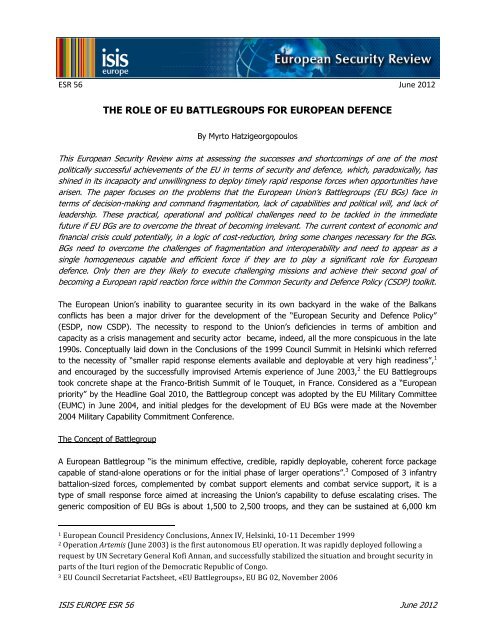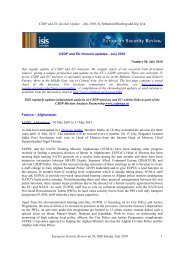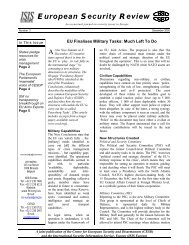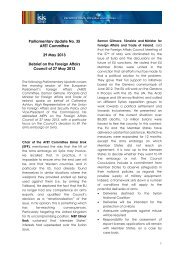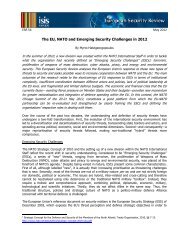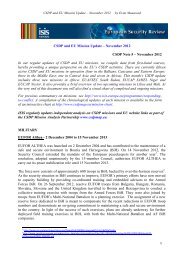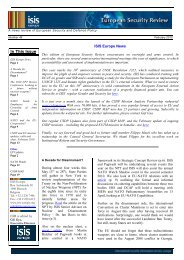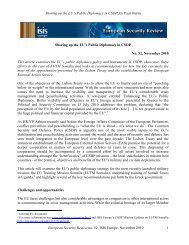the role of eu battlegroups for european defence - ISIS Europe
the role of eu battlegroups for european defence - ISIS Europe
the role of eu battlegroups for european defence - ISIS Europe
You also want an ePaper? Increase the reach of your titles
YUMPU automatically turns print PDFs into web optimized ePapers that Google loves.
ESR 56 June 2012<br />
THE ROLE OF EU BATTLEGROUPS FOR EUROPEAN DEFENCE<br />
By Myrto Hatzigeorgopoulos<br />
This <strong>Europe</strong>an Security Review aims at assessing <strong>the</strong> successes and shortcomings <strong>of</strong> one <strong>of</strong> <strong>the</strong> most<br />
politically successful achievements <strong>of</strong> <strong>the</strong> EU in terms <strong>of</strong> security and <strong>defence</strong>, which, paradoxically, has<br />
shined in its incapacity and unwillingness to deploy timely rapid response <strong>for</strong>ces when opportunities have<br />
arisen. The paper focuses on <strong>the</strong> problems that <strong>the</strong> <strong>Europe</strong>an Union’s Battlegroups (EU BGs) face in<br />
terms <strong>of</strong> decision-making and command fragmentation, lack <strong>of</strong> capabilities and political will, and lack <strong>of</strong><br />
leadership. These practical, operational and political challenges need to be tackled in <strong>the</strong> immediate<br />
future if EU BGs are to overcome <strong>the</strong> threat <strong>of</strong> becoming irrelevant. The current context <strong>of</strong> economic and<br />
financial crisis could potentially, in a logic <strong>of</strong> cost-reduction, bring some changes necessary <strong>for</strong> <strong>the</strong> BGs.<br />
BGs need to overcome <strong>the</strong> challenges <strong>of</strong> fragmentation and interoperability and need to appear as a<br />
single homogeneous capable and efficient <strong>for</strong>ce if <strong>the</strong>y are to play a significant <strong>role</strong> <strong>for</strong> <strong>Europe</strong>an<br />
<strong>defence</strong>. Only <strong>the</strong>n are <strong>the</strong>y likely to execute challenging missions and achieve <strong>the</strong>ir second goal <strong>of</strong><br />
becoming a <strong>Europe</strong>an rapid reaction <strong>for</strong>ce within <strong>the</strong> Common Security and Defence Policy (CSDP) toolkit.<br />
The <strong>Europe</strong>an Union’s inability to guarantee security in its own backyard in <strong>the</strong> wake <strong>of</strong> <strong>the</strong> Balkans<br />
conflicts has been a major driver <strong>for</strong> <strong>the</strong> development <strong>of</strong> <strong>the</strong> “<strong>Europe</strong>an Security and Defence Policy”<br />
(ESDP, now CSDP). The necessity to respond to <strong>the</strong> Union’s deficiencies in terms <strong>of</strong> ambition and<br />
capacity as a crisis management and security actor became, indeed, all <strong>the</strong> more conspicuous in <strong>the</strong> late<br />
1990s. Conceptually laid down in <strong>the</strong> Conclusions <strong>of</strong> <strong>the</strong> 1999 Council Summit in Helsinki which referred<br />
to <strong>the</strong> necessity <strong>of</strong> “smaller rapid response elements available and deployable at very high readiness”, 1<br />
and encouraged by <strong>the</strong> successfully improvised Artemis experience <strong>of</strong> June 2003, 2 <strong>the</strong> EU Battlegroups<br />
took concrete shape at <strong>the</strong> Franco-British Summit <strong>of</strong> le Touquet, in France. Considered as a “<strong>Europe</strong>an<br />
priority” by <strong>the</strong> Headline Goal 2010, <strong>the</strong> Battlegroup concept was adopted by <strong>the</strong> EU Military Committee<br />
(EUMC) in June 2004, and initial pledges <strong>for</strong> <strong>the</strong> development <strong>of</strong> EU BGs were made at <strong>the</strong> November<br />
2004 Military Capability Commitment Conference.<br />
The Concept <strong>of</strong> Battlegroup<br />
A <strong>Europe</strong>an Battlegroup “is <strong>the</strong> minimum effective, credible, rapidly deployable, coherent <strong>for</strong>ce package<br />
capable <strong>of</strong> stand-alone operations or <strong>for</strong> <strong>the</strong> initial phase <strong>of</strong> larger operations”. 3 Composed <strong>of</strong> 3 infantry<br />
battalion-sized <strong>for</strong>ces, complemented by combat support elements and combat service support, it is a<br />
type <strong>of</strong> small response <strong>for</strong>ce aimed at increasing <strong>the</strong> Union’s capability to defuse escalating crises. The<br />
generic composition <strong>of</strong> EU BGs is about 1,500 to 2,500 troops, and <strong>the</strong>y can be sustained at 6,000 km<br />
1 <strong>Europe</strong>an Council Presidency Conclusions, Annex IV, Helsinki, 10-11 December 1999<br />
2 Operation Artemis (June 2003) is <strong>the</strong> first autonomous EU operation. It was rapidly deployed following a<br />
request by UN Secretary General K<strong>of</strong>i Annan, and successfully stabilized <strong>the</strong> situation and brought security in<br />
parts <strong>of</strong> <strong>the</strong> Ituri region <strong>of</strong> <strong>the</strong> Democratic Republic <strong>of</strong> Congo.<br />
3 EU Council Secretariat Factsheet, «EU Battlegroups», EU BG 02, November 2006<br />
<strong>ISIS</strong> EUROPE ESR 56 June 2012
The EU Battlegroups, by Myrto Hatzigeorgopoulos<br />
away from Brussels <strong>for</strong> 30 to 120 days. The structure <strong>of</strong> <strong>the</strong> <strong>battlegroups</strong> is not fixed, and <strong>the</strong>y can be<br />
tailored depending on <strong>the</strong> specific requirement <strong>of</strong> a mission via attaching maritime, air, logistical or o<strong>the</strong>r<br />
special enablers such as Special Forces. The contributing states set <strong>the</strong>mselves <strong>the</strong> goal <strong>of</strong> deploying on<br />
<strong>the</strong> ground within 10 days <strong>of</strong> an EU decision to launch an operation. Ei<strong>the</strong>r <strong>for</strong>med by a single EU<br />
Member State or by a so-called “framework state” with <strong>the</strong> support <strong>of</strong> contributing countries, it is<br />
commonly agreed that EU Battlegroups aim to achieve two goals: firstly, to enable rapid independent<br />
<strong>Europe</strong>an military response to crises, and secondly, to act as catalysts <strong>for</strong> <strong>the</strong> trans<strong>for</strong>mation <strong>of</strong> member<br />
states’ armed <strong>for</strong>ces and to increase cooperation and interoperability <strong>of</strong> <strong>Europe</strong>an national armies.<br />
Indeed, <strong>the</strong> 2003 <strong>Europe</strong>an Security Strategy (ESS) affirms that <strong>the</strong>re is a need “to trans<strong>for</strong>m our<br />
militaries into more flexible, mobile <strong>for</strong>ces and to enable <strong>the</strong>m to address <strong>the</strong> new threats”. 4<br />
Having originated after <strong>the</strong> prompt deployment <strong>of</strong> operation Artemis in June 2003, <strong>the</strong> EU BGs were<br />
initially meant to deploy upon <strong>for</strong>mal UN request, generally as a “bridging” or “initial entry <strong>for</strong>ce”.<br />
However, <strong>the</strong>ir scope has quickly been extended to autonomous rapid response operations and standalone<br />
operations to solve limited-size crises. The Battlegroup Concept stipulates that <strong>the</strong> units should be<br />
able to carry out <strong>the</strong> entire range <strong>of</strong> operations listed in <strong>the</strong> Petersberg tasks, and as complemented with<br />
those identified in <strong>the</strong> 2003 ESS (reviewed in 2008), ranging from humanitarian aid and peace<br />
en<strong>for</strong>cement operations to crisis management, assistance to security sector re<strong>for</strong>m and post-conflict<br />
stabilization. 5 Since BGs reached initial operational capability (IOC) in January 2005, a minimum <strong>of</strong> one<br />
BG has constantly been on standby <strong>for</strong> 6 months. The objective <strong>of</strong> <strong>the</strong> Battlegroups after reaching <strong>the</strong>ir<br />
full operational capability (FOC) was to enable <strong>the</strong> EU to undertake two concurrent single BG-sized rapid<br />
response operations, launched almost simultaneously.<br />
The costs and responsibility <strong>of</strong> planning, setting up, training, certifying, putting toge<strong>the</strong>r and making <strong>the</strong><br />
Battlegroups available to <strong>the</strong> EU lies with <strong>the</strong> troop-contributing nations, and primarily, with <strong>the</strong><br />
framework nation. The standard practices associated with military CSDP operations apply. The “common<br />
costs” related to <strong>the</strong> operational headquarters, local administration, transportation within <strong>the</strong> Operational<br />
Headquarters (OHQ) area, and lodging infrastructures are administered through <strong>the</strong> “A<strong>the</strong>na”<br />
mechanism. “Individual costs” (transport <strong>of</strong> troops from individual countries to <strong>the</strong> area <strong>of</strong> operations), as<br />
well as o<strong>the</strong>r costs linked to stand-up preparations and placing <strong>the</strong> EU BG on standby <strong>the</strong> responsibility <strong>of</strong><br />
contributing states according to <strong>the</strong> principle <strong>of</strong> “costs lie where <strong>the</strong>y fall”. 6 However, given <strong>the</strong> fact that<br />
costs jointly covered through A<strong>the</strong>na make up just 10% <strong>of</strong> <strong>the</strong> total maintenance and operational costs <strong>of</strong><br />
an EU BG, <strong>the</strong> bulk <strong>of</strong> <strong>the</strong> burden is provided by contributing nations, and especially by <strong>the</strong> framework<br />
nation, both in terms <strong>of</strong> cost-sharing and risk-sharing in case an operation is undertaken. 7 Consequently,<br />
many EU Member States have been prevented from taking <strong>the</strong> lead as framework nations, or even from<br />
playing a larger <strong>role</strong> in a BG <strong>for</strong>mation.<br />
Despite <strong>the</strong> initial political success <strong>of</strong> <strong>the</strong> BG Concept, Member States’ commitment to BGs seems to be<br />
currently experiencing a downturn. Indeed, five years after FOC was reached, not a single Battlegroup<br />
4 Gustav Lindstrom, «Enter <strong>the</strong> EU Battlegroups», Chaillot paper 97 (Feb. 2007), pp. 63-64<br />
5 «EU Battlegroups»,<br />
http://www.<strong>eu</strong>roparl.<strong>eu</strong>ropa.<strong>eu</strong>/meetdocs/2004_2009/documents/dv/<strong>eu</strong>_<strong>battlegroups</strong>_/<strong>eu</strong>_<strong>battlegroups</strong>_e<br />
n.pdf, p. 2<br />
6 Gustav Lindstrom, Ibid., pp. 25-26<br />
7 The Nordic BG is assumed to have cost Sweden more than 1.2 billion Swedish Krona (€130 million) during<br />
<strong>the</strong> first term <strong>of</strong> 2008, without having been used.<br />
<strong>ISIS</strong> EUROPE ESR 56 June 2012
The EU Battlegroups, by Myrto Hatzigeorgopoulos<br />
has ever been deployed, while an increasing number <strong>of</strong> slots remain despairingly blank on <strong>the</strong> roster (c.f.<br />
Annex I). The longer EU BGs are not deployed, <strong>the</strong> more pressing <strong>the</strong> question <strong>of</strong> <strong>the</strong>ir existence, viability<br />
and employability become.<br />
The challenges <strong>of</strong> EU Battlegroups<br />
Beyond <strong>the</strong> political statement that contribution to <strong>the</strong> BGs represents, <strong>the</strong> actual record <strong>of</strong> achievements<br />
<strong>of</strong> BG is ra<strong>the</strong>r disappointing. Indeed, <strong>the</strong> concept in itself and its application within <strong>the</strong> EU suffer from a<br />
significant number <strong>of</strong> structural and agency flaws that subsume challenges at <strong>the</strong> practical, operational<br />
and political levels. They encompass fragmentation, lack <strong>of</strong> capabilities and political will, and lack <strong>of</strong><br />
leadership. These issues reflect difficulties inherent to any ef<strong>for</strong>ts made to fur<strong>the</strong>r <strong>Europe</strong>an integration in<br />
<strong>the</strong> fields <strong>of</strong> security and <strong>defence</strong>. Moreover, <strong>the</strong> BGs’ relationship with similar <strong>for</strong>mations such as <strong>the</strong><br />
NATO Response Force (NRF) has to be taken into account, given <strong>the</strong> potential mutual practical and<br />
operational “blockage” that could be triggered if overlaps in terms <strong>of</strong> <strong>for</strong>ce rotations, personnel and<br />
headquarters committed to both <strong>for</strong>ces are not solved.<br />
Practical/operational achievements and challenges<br />
With regards to <strong>the</strong>ir first goal, <strong>the</strong> setting up <strong>of</strong> Battlegroups has indeed somehow boosted national<br />
armed <strong>for</strong>ces’ trans<strong>for</strong>mation and cooperation; <strong>the</strong> results are, however, variable. When looking at <strong>the</strong><br />
Nordic Battlegroup (NBG), EU BGs have not only been a driving <strong>for</strong>ce <strong>for</strong> <strong>the</strong> restructuring <strong>of</strong> Swedish<br />
armed <strong>for</strong>ces from <strong>the</strong>ir traditional static territory-focused <strong>for</strong>ces to flexible mission-based <strong>for</strong>ces, but<br />
<strong>the</strong>y have also triggered <strong>the</strong> creation <strong>of</strong> comprehensive inter-parliamentary cooperation among <strong>the</strong> states<br />
<strong>of</strong> <strong>the</strong> <strong>for</strong>mation. 8 However, given <strong>the</strong> small section <strong>of</strong> <strong>for</strong>ces concerned by <strong>the</strong>se changes and given <strong>the</strong><br />
short period <strong>of</strong> <strong>the</strong>ir operational readiness (6 months), <strong>the</strong>se successes are ra<strong>the</strong>r limited; in most cases,<br />
EU BGs have not generated structural changes <strong>of</strong> national structures and capabilities as initially aimed.<br />
Claudia Major and Christian Mölling, from <strong>the</strong> Stiftung Wissenschaft und Politik (SWP) in Berlin, note that<br />
at <strong>the</strong> national level, <strong>the</strong> most significant progresses have been restricted to <strong>the</strong> areas <strong>of</strong> political<br />
decision-making, military planning, logistics, and command procedures. 9 Although advances have been<br />
made to overcome equipment and skills gaps (notably through outsourcing and pooling and sharing<br />
initiatives), <strong>the</strong> upgrading <strong>of</strong> equipment is ra<strong>the</strong>r minor; fundamental military hardware deficits in areas<br />
such as airlift capacity and battlefield surveillance persist.<br />
The relative flexibility <strong>of</strong> BGs certification plays <strong>the</strong> <strong>role</strong> <strong>of</strong> a double edge sword in a context <strong>of</strong> limited<br />
shared understanding <strong>of</strong> <strong>the</strong> required overarching standards: on <strong>the</strong> one hand side, it allows <strong>for</strong> easier<br />
<strong>for</strong>ce generation, greater operational and structural adaptation <strong>of</strong> <strong>the</strong> “<strong>for</strong>ce packages” to <strong>the</strong><br />
requirements <strong>of</strong> specific operations and enables contributors to rely on standards that <strong>the</strong>y are familiar<br />
with. On <strong>the</strong> o<strong>the</strong>r hand, it can affect interoperability within and across <strong>for</strong>ce packages, and results in<br />
considerable differences among different EU BGs, both in <strong>the</strong>ir level <strong>of</strong> capabilities and readiness. The<br />
lack <strong>of</strong> training at <strong>the</strong> EU level can only fur<strong>the</strong>r rein<strong>for</strong>ce <strong>the</strong> impact <strong>of</strong> <strong>the</strong> lack <strong>of</strong> harmonized standards,<br />
which in return, has considerable importance <strong>for</strong> potential cooperation and interoperability. These<br />
a<strong>for</strong>ementioned challenges can result in “credibility gaps” that would affect <strong>the</strong> entire EU BG not only in<br />
terms <strong>of</strong> mutual trust, but also in terms <strong>of</strong> overall credibility and actual military effectiveness. The<br />
8 http://www.<strong>for</strong>svarsmakten.se/en/Organisation/Nordic-Battlegroup/The-Battlegroup-concept/<br />
9 Claudia Major & Christian Mölling, «EU Battlegroups : What contribution to <strong>Europe</strong>an Defence», SWP<br />
Research Paper (June 2011), pp. 14-25<br />
<strong>ISIS</strong> EUROPE ESR 56 June 2012
The EU Battlegroups, by Myrto Hatzigeorgopoulos<br />
cooperation and interoperability <strong>of</strong> EU armed <strong>for</strong>ces that <strong>the</strong> EU BGs aim at achieving is, thus, limited,<br />
while <strong>the</strong> military effectiveness <strong>of</strong> <strong>the</strong> BG concept but also <strong>of</strong> different BG <strong>for</strong>mations cannot be assessed<br />
in <strong>the</strong> absence <strong>of</strong> concrete operational experience.<br />
A last fundamental issue with regard to EU BGs’ operational capacity relates to <strong>the</strong> adequation between<br />
<strong>the</strong> tasks that <strong>the</strong>y have been set up <strong>for</strong> (i.e. extended Petersberg tasks & ESS), and <strong>the</strong>ir limited size,<br />
capabilities and sustainability. As warned by <strong>the</strong> EU Council Secretariat Factsheet on BGs, BGs can reach<br />
<strong>the</strong>ir “full potential in tasks <strong>of</strong> combat <strong>for</strong>ces in crisis management, bearing in mind <strong>the</strong>ir limited size”. 10<br />
As it has very widely been argued, “Battlegroups are not suited <strong>for</strong> stand-alone or prolonged deployment<br />
in high-intensity operations”. 11 There is indeed a significant capabilities-expectations gap, which<br />
practically renders EU BGs unlikely to handle stand-alone combat operations on <strong>the</strong> medium- to hard-end<br />
<strong>of</strong> military utility, especially given that no strategic reserve <strong>for</strong>ce <strong>for</strong> <strong>the</strong> EU BGs has been set up. Better<br />
suited <strong>for</strong> rapid pre-emptive operations limited both in space and time, EU BGs are probably more<br />
adapted to operate within a clearly delimited military and political framework and in a low to mediumintensity<br />
context, where “normal” <strong>for</strong>ces cannot be mobilised and deployed because <strong>of</strong> <strong>the</strong> urgency<br />
looming on normal <strong>for</strong>ce generation procedures.<br />
Political decision-making process and <strong>the</strong> question <strong>of</strong> deployment<br />
The problems arising from <strong>the</strong> fragmentation <strong>of</strong> <strong>the</strong> planning and decision-making structures and<br />
capacities are two-fold and inter-related; <strong>the</strong>y comprise both <strong>the</strong> national and <strong>Europe</strong>an political rustles<br />
within <strong>the</strong> planning and decision-making processes and structures <strong>the</strong>mselves, as well as <strong>the</strong> tight<br />
timeline assigned <strong>for</strong> rapid-response deployment. Indeed, a ra<strong>the</strong>r large number <strong>of</strong> actors and decisional<br />
levels are involved in <strong>the</strong> strategic and military planning and decision-making processes preceding a <strong>for</strong>ce<br />
deployment (c.f. Annex II). National caveats, legal requirements or lengthy procedures play an important<br />
<strong>role</strong>. With this regard, some progress has been reached by member states to facilitate and shorten<br />
procedures (c.f. inter-parliamentary cooperation <strong>of</strong> <strong>the</strong> NBG). However, planning, decision-making and<br />
command coordination between <strong>the</strong> EU and national levels remain clearly insufficient, 12 <strong>the</strong>reby hindering<br />
<strong>the</strong> EU BGs’ potential ability to react in due time and <strong>for</strong>m. Adequate synchronization <strong>of</strong> lengthy national<br />
decision-making processes with strained <strong>Europe</strong>an decision-making processes constitutes a primary<br />
challenge in a context where central planning and command capacities at <strong>the</strong> political-strategic level, in<br />
Brussels, are only limited. However, <strong>the</strong> recent first-ever activation <strong>of</strong> <strong>the</strong> EU Operations Centre (Ops<br />
Centre, established on 1 January 2007) “to improve coordination and streng<strong>the</strong>n civil-military synergies<br />
between <strong>the</strong> three CSDP actions in <strong>the</strong> Horn <strong>of</strong> Africa” 13/14 , on 23 March 2012, may potentially impact <strong>the</strong><br />
issue <strong>of</strong> <strong>Europe</strong>an fragmentation <strong>of</strong> <strong>the</strong> planning and command structure. The efficiency and outcomes <strong>of</strong><br />
this first utilisation <strong>of</strong> <strong>the</strong> Ops Centre is likely to pave (or block) <strong>the</strong> way towards <strong>the</strong> provision <strong>of</strong> suitable<br />
EU Operational Headquarters.<br />
10 EU Council Secretariat Factsheet, «EU Battlegroups», EU BG 02, November 2006<br />
11 Claudia Major & Christian Mölling, Ibid., p. 19<br />
12 Ibid., p. 6<br />
13 Factsheet – “The activation <strong>of</strong> <strong>the</strong> EU Operations Centre”,<br />
http://www.consilium.<strong>eu</strong>ropa.<strong>eu</strong>/media/1634515/factsheet_opscentre_22_may_12.pdf<br />
14 The EU is currently conducting a military operation (EUNAVFOR Operation ATALANTA) and a military<br />
mission (EU Training Mission Somalia – EUTM Somalia). The planning <strong>of</strong> <strong>the</strong> civilian mission (EUCAP<br />
NESTOR) is in its final stage and <strong>the</strong> mission we be launched over <strong>the</strong> summer 2012.<br />
<strong>ISIS</strong> EUROPE ESR 56 June 2012
The EU Battlegroups, by Myrto Hatzigeorgopoulos<br />
EU BGs have so far not been validated in practice. Notwithstanding <strong>the</strong> ra<strong>the</strong>r widespread “lack <strong>of</strong><br />
opportunities” discourse among EU <strong>of</strong>ficials and member states, <strong>the</strong> fact is that <strong>the</strong> deployment <strong>of</strong><br />
Battlegroups has been considered quite <strong>of</strong>ten since <strong>the</strong>ir setting up; in <strong>the</strong> cases <strong>of</strong> DR Congo and<br />
Lebanon in 2006, <strong>of</strong> Eastern DR Congo and Chad in 2008, <strong>of</strong> Haiti in 2010, and <strong>of</strong> Libya in 2011. It has<br />
even recently been suggested by Political and Security Committee (PSC) ambassadors, that BGs could<br />
potentially be used to bring military support to EUFOR Al<strong>the</strong>a. If opportunities arise and if <strong>the</strong>re is general<br />
consent and support <strong>for</strong> <strong>the</strong> concept <strong>of</strong> BGs, why has deployment never occurred? Firstly, cost<br />
considerations heavily affect individual member states’ decisions on deployment. If on a conceptual basis<br />
Member states agree on <strong>the</strong> deployment <strong>of</strong> a BG, <strong>the</strong>ir reluctance to deploy <strong>the</strong>ir own Battlegroup is quite<br />
significant. This first argument reflects <strong>of</strong> course a fundamental flaw related to <strong>the</strong> cost and burdensharing<br />
calculations <strong>of</strong> <strong>the</strong> BG concept. Secondly, if opportunities have indeed arisen, it remains unclear if<br />
<strong>the</strong> required concrete conditions laid down <strong>for</strong> <strong>the</strong> potential development <strong>of</strong> an EU BG are met. Thus, it<br />
can be argued that <strong>the</strong>re is a lack <strong>of</strong> consensus on <strong>the</strong> types <strong>of</strong> tasks that BGs should take on.<br />
Fur<strong>the</strong>rmore, <strong>the</strong> assessment <strong>of</strong> a crisis and <strong>of</strong> <strong>the</strong> necessity to use <strong>for</strong>mations on standby is a matter <strong>of</strong><br />
strategic culture and <strong>of</strong> political discretion, but it also relates to a third factor; unanimous agreement<br />
between Member States on <strong>the</strong> <strong>role</strong> <strong>of</strong> <strong>the</strong> EU on <strong>the</strong> international stage, on its strategic goals and more<br />
fundamentally, on <strong>the</strong> use <strong>of</strong> military <strong>for</strong>ce, that constitute never-ending barriers to <strong>the</strong> concretisation <strong>of</strong><br />
<strong>the</strong> EU as a significant international actor. The Union has proved its availability and willingness to engage<br />
militarily by using o<strong>the</strong>r instruments at its disposal than EU BG to respond to a number <strong>of</strong> recent crises<br />
(RD Congo 2006, Chad and <strong>the</strong> Central African Republic in 2008/09); but it has simultaneously<br />
highlighted how BGs shortfalls overburden <strong>the</strong>ir employability, probably sentencing <strong>the</strong>m to remaining on<br />
<strong>the</strong> sidelines <strong>for</strong> <strong>the</strong> <strong>for</strong>eseeable future.<br />
Battlegroups and NATO Response Force<br />
Finally, <strong>the</strong> relationship between EU and NATO, and especially between EU BGs and NATO Response<br />
Force (NRF), is worth being discussed. Both <strong>for</strong>mations having set <strong>the</strong>mselves similar objectives and<br />
tasks, and both organisations sharing almost ¾ <strong>of</strong> <strong>the</strong>ir respective member states and already competing<br />
over <strong>the</strong>ir respective <strong>role</strong>s in <strong>the</strong> international security arena, <strong>the</strong> question <strong>of</strong> duplication <strong>of</strong> capabilities is<br />
central to <strong>the</strong> BGs-NRF debate. If <strong>the</strong>re are considerable differences with regard to <strong>the</strong> size and<br />
composition <strong>of</strong> <strong>the</strong> packages (NRF is a brigade-sized joint <strong>for</strong>ce, comprising roughly 25,000 troops; it has<br />
land, maritime and air components and benefits from harmonized standards and certification<br />
programmes), <strong>the</strong> conceptual, operational and membership overlap is highlighted by similar shortfalls<br />
faced by both <strong>for</strong>ce packages. In particular, <strong>the</strong>re is a need to coordinate <strong>for</strong>ce rotations across EU BG<br />
and NRF preparation and standby requirements that currently render <strong>for</strong>ces committed to <strong>the</strong> NRF unable<br />
to serve on an EU BG <strong>for</strong>mation <strong>for</strong> around 2 years. 15 Closer cooperation, transparency and coordination<br />
between <strong>the</strong> EU and NATO is definitely required within a coherent EU-NATO capability group, organizing<br />
regular high-level meetings to address overall coherence and complementarity <strong>of</strong> <strong>the</strong> <strong>for</strong>ces. Contrary to<br />
what was stated in <strong>the</strong> EEAS’s 2011 note on <strong>the</strong> Development <strong>of</strong> <strong>Europe</strong>an Military Capabilities, it is not<br />
only “<strong>for</strong> member states concerned to resolve any difficulties concerning compatibility with <strong>the</strong>ir<br />
commitments to o<strong>the</strong>r organisations, in particular in <strong>the</strong> NATO Response Force (NRF)”. 16<br />
15 Gustav Lindstrom, p. 49<br />
16 EEAS, «Development <strong>of</strong> <strong>Europe</strong>an Military Capabilities», January 2011, Military Capabilities/8, p. 5<br />
<strong>ISIS</strong> EUROPE ESR 56 June 2012
The EU Battlegroups, by Myrto Hatzigeorgopoulos<br />
The Battlegroups in 2012: battling <strong>for</strong> revitalisation<br />
In recent years, different Council Presidencies have attempted to play a leading <strong>role</strong> in <strong>the</strong> revitalisation<br />
<strong>of</strong> EU BGs. In <strong>the</strong> second term <strong>of</strong> 2009, <strong>the</strong> Swedish Presidency had ambitiously wanted to tackle <strong>the</strong><br />
issue <strong>of</strong> deployment by “increasing <strong>the</strong> flexibility and usability <strong>of</strong> <strong>the</strong> EU Battlegroups”, 17 which, however,<br />
only had a minor impact on BG employability as it left a number <strong>of</strong> important issues such as <strong>the</strong> problem<br />
<strong>of</strong> capabilities shortfalls, and risk and financial burden-sharing <strong>of</strong>f <strong>the</strong> agenda. Fur<strong>the</strong>rmore, political<br />
challenges could naturally not be overcome through technical and practical engineering. The Initiative<br />
launched by <strong>the</strong> “Weimar Triangle” (Poland, France, Germany) in April 2011, to create a permanent civilmilitary<br />
planning and command structure <strong>for</strong> EU operations, gained renewed momentum under <strong>the</strong> Polish<br />
presidency <strong>of</strong> <strong>the</strong> EU Council in <strong>the</strong> second term <strong>of</strong> 2011. Indeed, <strong>the</strong> Polish presidency placed <strong>the</strong><br />
Weimar Triangle Initiatives at <strong>the</strong> centre <strong>of</strong> its presidency programme to revitalise CSDP and EU BGs:<br />
developing BGs into civil-military crisis response <strong>for</strong>ces, setting-up civil-military planning and command<br />
structures at <strong>the</strong> EU level and enhancing Pooling and Sharing (P&S). 18 The Polish initiative has to be<br />
analysed in <strong>the</strong> light <strong>of</strong> poor CSDP per<strong>for</strong>mance in 2011 (bilateral UK-French military operation outside<br />
<strong>the</strong> EU framework in Libya, German preference <strong>for</strong> NATO arms embargo etc.), insufficient political<br />
leadership in CSDP matters, and <strong>the</strong> financial crisis. 19 In spite <strong>of</strong> <strong>the</strong> presidency’s dynamic ef<strong>for</strong>ts, little<br />
has been achieved. The Council Conclusions on CSDP <strong>of</strong> December 2011 call <strong>for</strong> enhanced cooperation on<br />
strategic enablers and niche capabilities, enhanced interaction between <strong>the</strong> BG and <strong>the</strong> EU level, and<br />
fur<strong>the</strong>r work on <strong>the</strong> review <strong>of</strong> <strong>the</strong> A<strong>the</strong>na mechanism. With regard to <strong>the</strong> initiative <strong>of</strong> setting up<br />
permanent, civil-military EU planning and command structures, <strong>the</strong> document only envisages “<strong>the</strong><br />
possibilities <strong>for</strong> Battlegroup interaction with civilian actors”. Civil-military integration is, however,<br />
necessary <strong>for</strong> <strong>the</strong> EU BGs to successfully complete <strong>the</strong>ir tasks and to be able to meet <strong>the</strong> requirements <strong>of</strong><br />
future operations; analysts note that rapid military response can only reach its full potential when<br />
included in a wider comprehensive strategy, addressing <strong>the</strong> broad range <strong>of</strong> crises’ root causes, from<br />
political to social and economic factors. 20 Civilian considerations and instruments shall <strong>the</strong>re<strong>for</strong>e be<br />
introduced into <strong>the</strong> whole process from preventive steps to <strong>the</strong> actual planning, deployment and postwithdrawal<br />
period <strong>of</strong> military operations. Finally, as EU BGs are more likely to be used as “bridging” or<br />
“initial entry <strong>for</strong>ce”, <strong>the</strong> EU should work on fur<strong>the</strong>r integrating <strong>the</strong>m in <strong>the</strong> wider picture and in <strong>the</strong><br />
planning <strong>of</strong> <strong>the</strong> follow-on longer-term operation.<br />
On 1 January 2012, Denmark took over <strong>the</strong> Presidency <strong>of</strong> <strong>the</strong> Council <strong>of</strong> <strong>the</strong> <strong>Europe</strong>an Union from Poland.<br />
This handover was <strong>of</strong> primary importance <strong>for</strong> <strong>the</strong> EU’s Common Defence and Security Policy because <strong>of</strong><br />
<strong>the</strong> Danish <strong>defence</strong> “opt-out” which keeps it away from EU-led military operations and from discussions<br />
over <strong>the</strong> development <strong>of</strong> military capabilities within <strong>the</strong> EU. There<strong>for</strong>e, <strong>the</strong> re<strong>for</strong>m dynamic <strong>of</strong> <strong>the</strong> recent<br />
years is currently slowing down and has shifted away from Council Presidencies’ initiatives into <strong>the</strong> hands<br />
<strong>of</strong> <strong>the</strong> Crisis Management and Planning Directorate (CMPD). As it appears from <strong>the</strong> May 2012 CMPD<br />
report on Battlegroups, <strong>the</strong> concept still benefits from wide support among CSDP member states. Many,<br />
however, mention <strong>the</strong> lack <strong>of</strong> political will and, some o<strong>the</strong>rs, <strong>the</strong> cost <strong>of</strong> participation and <strong>the</strong> lack <strong>of</strong><br />
17 Council <strong>of</strong> <strong>the</strong> <strong>Europe</strong>an Union note, 15336/09<br />
18 c.f. Myrto Hatzigeorgopoulos, « The EU, NATO, and Emerging Security Challenges », <strong>ISIS</strong>-<strong>Europe</strong> <strong>Europe</strong>an<br />
Security Review 54, pp. 5-6,<br />
http://www.isis-<strong>eu</strong>rope.<strong>eu</strong>/sites/default/files/publications-downloads/esr54-EU-NATOemergingchallenges-<br />
May2012%20MH_0.pdf<br />
19 Claudia Major & Florian Wassenberg, «Warsaw’s Ambitious CSDP Agenda», SWP Comment (Sept. 2011) pp.<br />
1-3<br />
20 Claudia Major & Christian Mölling, Ibid., p. 9<br />
<strong>ISIS</strong> EUROPE ESR 56 June 2012
The EU Battlegroups, by Myrto Hatzigeorgopoulos<br />
critical capabilities, to explain <strong>the</strong> blanks in <strong>the</strong> contribution roster. Indeed, <strong>the</strong> current economic and<br />
financial context, heavily weighing on national <strong>defence</strong> budgets, has created renewed momentum on P&S<br />
as a means to step-up spending efficiency and keep, at <strong>the</strong> EU level, essential capabilities that could not<br />
be ga<strong>the</strong>red by member states alone. This is an opportunity to overcome a number <strong>of</strong> limitations<br />
mentioned above by enhancing, expanding and fur<strong>the</strong>r integrating member states capabilities and<br />
sustainability within recurrent/regular BG <strong>for</strong>mations. CMPD, <strong>the</strong>re<strong>for</strong>e, envisaged to recast BGs<br />
contributions on framework nations from 2015 and onwards, on <strong>the</strong> basis <strong>of</strong> a regular rotation among<br />
<strong>the</strong>mselves, with o<strong>the</strong>r member states adding <strong>the</strong>ir own contributions to <strong>the</strong> core roster within a regional<br />
and/or partnership approach.<br />
Renewed focus on P&S has also provided impetus <strong>for</strong> joint procurement initiatives and <strong>for</strong> entrusting <strong>the</strong><br />
<strong>Europe</strong>an Defence Agency (EDA) with more responsibility on EU BG related matters, and especially, in<br />
acquiring support packages <strong>for</strong> <strong>for</strong>mations. The German, Czech and Austrian Defence Ministers recently<br />
agreed to launch joint procurement initiatives <strong>for</strong> <strong>the</strong> acquisition <strong>of</strong> basic logistic support means <strong>for</strong><br />
Battlegroups. 21 In parallel, <strong>the</strong> Visegrad Defence Ministers 22 engaged in talks on <strong>the</strong> acquisition <strong>of</strong> joint<br />
radar surveillance technology. The EDA estimated savings through grouped procurement to be up to<br />
20%. 23 The establishment <strong>of</strong> an Early Warning and Deployment Management System and <strong>of</strong> a Military<br />
Health and Medical Support coordination Unit to tackle financial and capabilities shortfalls was also raised<br />
in <strong>the</strong> CMPD report. Fur<strong>the</strong>r logistic outsourcing, fur<strong>the</strong>r use <strong>of</strong> <strong>the</strong> EDA and regular recourse to<br />
cooperative solutions (framework support contracts <strong>for</strong> fuel, transport, satellite communication etc.),<br />
including P&S, are also clearly recommended. 24 Ironically enough, although <strong>the</strong> current context <strong>of</strong><br />
strained <strong>defence</strong> budgets has produced sustained incentives <strong>for</strong> member states’ investment in <strong>the</strong> search<br />
<strong>for</strong> new ways to share costs and pool resources associated with EU BGs, it is feared that <strong>the</strong>se very<br />
countries, at <strong>the</strong> same time, may look <strong>for</strong> ways to avoid <strong>the</strong> activation <strong>of</strong> <strong>the</strong>ir EU BG during a time <strong>of</strong><br />
crisis. Such a development would clearly constitute a major blow to <strong>the</strong> perceived viability <strong>of</strong> <strong>the</strong> EU BG<br />
concept.<br />
The upcoming Cypriot presidency, <strong>the</strong> political deadlock in Cyprus-Turkey relations and <strong>the</strong> lack <strong>of</strong> a<br />
<strong>for</strong>mal Cyprus-NATO dialogue that accompanies it, heavily constrains Cyprus’ likelihood to bring about<br />
any significant change or initiative on EU BGs and CSDP. Increased cooperation with NATO, which<br />
constituted one <strong>of</strong> <strong>the</strong> cornerstones <strong>of</strong> <strong>the</strong> Polish Presidencies’ priorities <strong>for</strong> CSDP, will most certainly not<br />
result in <strong>the</strong> envisaged (and much-needed) “enhanced Berlin Plus Agreements” over <strong>the</strong> second term <strong>of</strong><br />
2012.<br />
21 Decision <strong>of</strong> March 2012 and project to be launched in <strong>the</strong> second half <strong>of</strong> 2012<br />
22 Mr. Csaba Hende, from Hungary; Mr. Martin Glváč, from <strong>the</strong> Slovak Republic; and Mr. Alexandr Vondra,<br />
from <strong>the</strong> Czech Republic<br />
23 «EU/CSDP: EDA ideas <strong>for</strong> doing more in <strong>defence</strong> with little investment», <strong>Europe</strong> Diplomatie & Défense<br />
23/03/2012, N°499, p. 5<br />
24 «EU/CSDP : CMPD suggests group <strong>of</strong> framework nations should shoulder responsibility <strong>for</strong> making up<br />
battlegroup shortfall», <strong>Europe</strong> Diplomatie & Défense, 24/05/2012, N°517, p. 3<br />
<strong>ISIS</strong> EUROPE ESR 56 June 2012
The EU Battlegroups, by Myrto Hatzigeorgopoulos<br />
Conclusion<br />
As it has been mentioned, in <strong>the</strong>ir inception, EU BGs were meant to achieve two objectives: act as a<br />
major engine <strong>of</strong> trans<strong>for</strong>mation <strong>of</strong> national armed <strong>for</strong>ces on <strong>the</strong> one hand, and enable independent,<br />
timely, rapid and decisive <strong>Europe</strong>an reaction on <strong>the</strong> o<strong>the</strong>r. When assessing <strong>the</strong>ir achievements after five<br />
years <strong>of</strong> FOC, <strong>the</strong>y seem to have brought about some progress with regard to <strong>the</strong>ir first objective, while<br />
<strong>the</strong>ir credibility in undertaking rapid action in <strong>the</strong> framework <strong>of</strong> CSDP is ra<strong>the</strong>r controversial. In<br />
consequence, <strong>the</strong>ir added-value has been more significant <strong>for</strong> individual member states than <strong>for</strong> <strong>the</strong><br />
Union as a whole, and <strong>for</strong> its <strong>role</strong> as a global actor. The ef<strong>for</strong>ts made over <strong>the</strong> past three years to revise<br />
and make EU BGs more employable reveal that Gustav Lindstrom may have been right when he<br />
prophetically argued that “<strong>the</strong> first few years post-FOC will be vital to gauge whe<strong>the</strong>r or not <strong>the</strong> EU BGs<br />
will become an active part <strong>of</strong> <strong>the</strong> ESDP crisis management toolbox”. 25 Un<strong>for</strong>tunately, <strong>the</strong> pressure exerted<br />
on EU BGs is likely to fur<strong>the</strong>r hamper future deployment, <strong>for</strong> <strong>the</strong> Union and CSDP cannot af<strong>for</strong>d a<br />
potential military or political failure related to <strong>the</strong> never-deployed Battlegroups; however, waiting <strong>for</strong> <strong>the</strong><br />
ideal crisis may turn Battlegroups into a “<strong>for</strong>gotten” instrument <strong>of</strong> <strong>the</strong> CSDP toolkit.<br />
25 Gustav Lindstrom, Ibid., p. 64<br />
<strong>ISIS</strong> EUROPE ESR 56 June 2012
The EU Battlegroups, by Myrto Hatzigeorgopoulos<br />
Annex I<br />
EU Battlegroups rotation, commitment and composition 2005-2017<br />
Semester<br />
Preferred<br />
OHQ<br />
2005<br />
1 st semester UK<br />
France<br />
2 nd semester Italy<br />
vacant<br />
2006<br />
1 st semester France, Germany<br />
Spain, Italy, Greece, Portugal<br />
2 nd semester France, Germany, Belgium FR<br />
vacant<br />
2007<br />
1 st semester France, Belgium FR<br />
Germany, Ne<strong>the</strong>rlands, Finland<br />
DE<br />
2 nd semester Italy, Hungary, Slovenia (“Multinational Land Force” MLF) IT<br />
Greece, Bulgaria, Cyprus, Romania (“HELBROC”)<br />
EL<br />
2008<br />
1 st semester Sweden, Finland, Estonia, Norway, Ireland (“Nordic”) SE<br />
Spain, France, Portugal, Germany<br />
2 nd semester Germany, France, Belgium, Luxembourg, Spain FR<br />
UK<br />
UK<br />
2009<br />
1 st semester Italy, Spain, Greece, Portugal (“SILF”)<br />
Greece, Bulgaria, Romania, Cyprus (“HELBROC”)<br />
EL<br />
2 nd semester Czech Republic, Slovakia<br />
France, Belgium, Luxembourg<br />
2010<br />
1 st semester Poland, Germany, Lithuania, Latvia, Slovakia<br />
UK, Ne<strong>the</strong>rlands<br />
2 nd semester Italy, Romania, + Turkey IT<br />
Spain, France, Portugal<br />
FR<br />
2011<br />
1 st semester Ne<strong>the</strong>rlands, Germany, Finland, Austria, Lithuania DE<br />
(“Saxon”)<br />
Sweden, Finland, Estonia, Ireland + Norway (“Nordic”) UK<br />
2 nd semester Greece, Bulgaria, Cyprus, Romania (“HELBROC”) EL<br />
Portugal, Spain, France, Italy (“Eur<strong>of</strong>or”)<br />
FR<br />
<strong>ISIS</strong> EUROPE ESR 56 June 2012
Initial <strong>of</strong>fers<br />
BG-package commitments<br />
Detailed commitments<br />
The EU Battlegroups, by Myrto Hatzigeorgopoulos<br />
2012<br />
1 st semester France, Belgium, Luxembourg FR<br />
vacant<br />
2 nd semester Italy, Slovenia, Hungary (“Multinational Land Force” MLF) IT<br />
Germany, Austria, Czech Republic, Ireland + Croatia & DE<br />
FYROM<br />
2013<br />
1 st semester Poland, Germany, France (“Weimar”) FR<br />
Vacant<br />
2 nd semester UK, Sweden*, Lithuania, Latvia UK<br />
Vacant<br />
2014<br />
1 st semester Greece, Bulgaria*, Romania, Cyprus (“HELBROC”) EL<br />
Vacant<br />
2 nd semester Belgium, Ne<strong>the</strong>rlands, Germany, Luxembourg, Spain DE<br />
Spain, Italy, Greece, Portugal<br />
EL<br />
2015<br />
1 st semester Sweden*, Finland*<br />
Vacant<br />
2 nd semester France, Belgium* FR<br />
Vacant<br />
2016<br />
1 st semester Poland, Hungary, Slovakia, Czech Republic (“Visegrad”)<br />
Vacant<br />
2 nd semester UK* UK<br />
Vacant<br />
2017<br />
1 st semester Vacant<br />
Vacant<br />
2 nd semester Vacant<br />
Vacant<br />
Source: <strong>Europe</strong>an Union Military Staff – June 2012<br />
Framework nation<br />
*Participation pending political decision<br />
+ third states<br />
<strong>ISIS</strong> EUROPE ESR 56 June 2012
The EU Battlegroups, by Myrto Hatzigeorgopoulos<br />
Annex II<br />
Battlegroups’ Timeline<br />
EU decision to take<br />
action<br />
within <strong>the</strong> Council <strong>of</strong><br />
<strong>the</strong> <strong>Europe</strong>an Union<br />
Crisis Management<br />
Concept<br />
prepared by <strong>the</strong> Crisis<br />
Management Planning<br />
Directorate (CMPD)<br />
[EEAS]<br />
Approval <strong>of</strong> Crisis<br />
Management<br />
Concept<br />
by individual Member<br />
States – can involve<br />
national Parliaments,<br />
heads <strong>of</strong> state,<br />
cabinets, UN<br />
mandate…<br />
Decision to launch<br />
operation<br />
by <strong>the</strong> Council <strong>of</strong> <strong>the</strong><br />
<strong>Europe</strong>an Union<br />
First <strong>for</strong>ces<br />
deployed in <strong>the</strong>atre<br />
no time constraints 5 days 10 days<br />
<strong>ISIS</strong> EUROPE ESR 56 June 2012


